Hungarian actor Ernst (or Ernö) Verebes (1902-1971) was a popular and elegant matinee idol of the German cinema in the silent and early sound period. Sadly his career was broken by the Nazis.
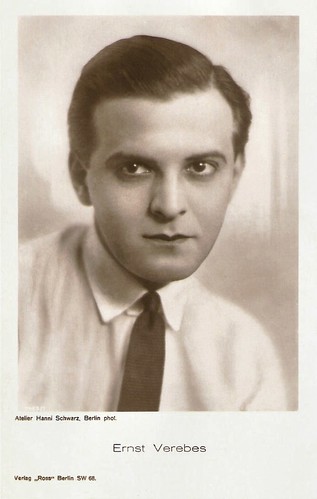
German postcard by Ross Verlag, no. 1483/1, 1926-1927. Photo: Hanni Schwarz, Berlin.
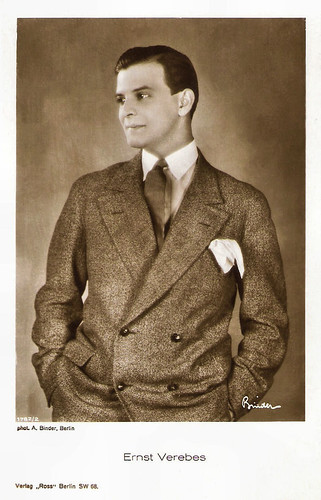
German postcard by Ross Verlag, no. 1782/2, 1926-1927. Photo: Alex Binder.
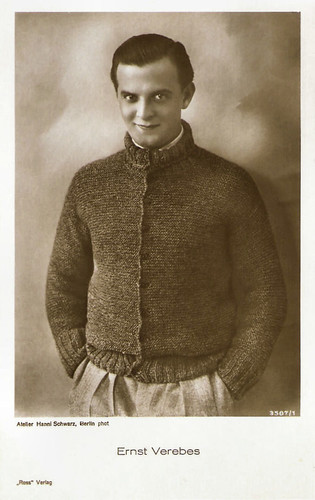
German postcard by Ross Verlag, no. 3507/1, 1928-1929. Photo: Atelier Hanni Schwarz, Berlin.
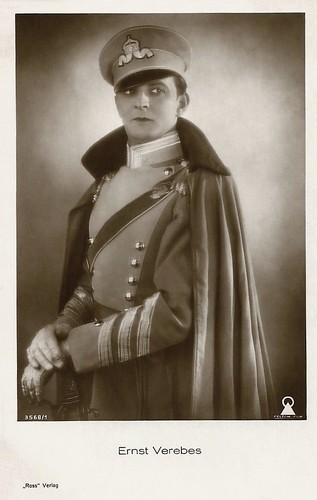
German postcard by Ross Verlag, no. 3568/1, 1928-1929. Photo: Felsom-Film. Publicity still for Der fesche Husar (Geza von Bolvary, 1929).
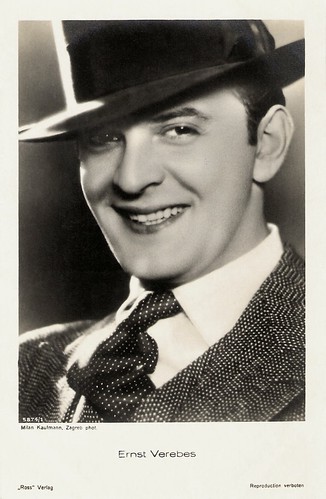
German postcard by Ross Verlag, no. 5874/1, 1930-1931. Photo: Milan Kaufmann, Zagreb.
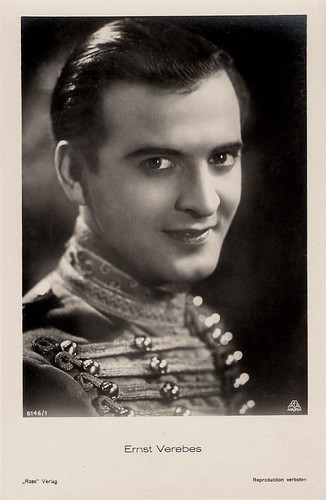
German postcard by Ross Verlag, no. 6146/1, 1931-1932. Photo: Aafa Film.
Ernst Verebes was born as Ernö Verebes in New York in 1902. In 1914 his family returned to Hungary and there his film career began with Mire megvénülünk/The Seventh Veil (Ödön Uher ifj., 1917) and the Charles Dickens adaptation Twist Olivér/Oliver Twist (Márton Garas, 1919).
In the 1920s he appeared in such Hungarian films as A hetedik Fatyol (János Vanicsek, 1922), A Pál-utcai fiúk (Béla Balogh, 1924) based on a novel by Ferenc Molnár, and Holnap kezdödik az élet (Antal Forgács, 1924) with Maria Corda.
From 1925 on he became established as Ernst Verebes in the German film industry. He appeared in such films as Der Mann im Sattel/The Man in the Saddle (Manfred Noa, 1925), Gräfin Mariza/Countess Mariza (Hans Steinhoff, 1925), and Qualen der Nacht/Torments of the Night (Kurt Bernhardt/Curtis Bernhardt, 1926) with Claire Rommer.
Guy Bellinger at IMDb writes: "he was one of those manly actors, both well-built and charming, at ease as well in a military uniform as in a tuxedo and top hat, that German ladies loved to see on a big screen." Many more films followed, including Bigamie/Bigamy (Jaap Speyer, 1927) starring Heinrich George, Der Geisterzug/Ghost Train (Géza von Bolvary, 1927), Der Bettelstudent/The Beggar Student (Jacob Fleck, Luise Fleck, 1927) with Harry Liedtke.
Verebes appeared as a count opposite Lya Mara in Der Zigeunerbaron/The Gypsy Baron (Friedrich Zelnik aka Frederic Zelnik, 1927), and starred in Das Land ohne Frauen/Bride Number 68 (Carmine Gallone, 1929). Incidentally he also made Hungarian films like A Pál-utcai fúk/Paul Street Boys (Bela Balogh, 1929), based on a novel by Ferenc Molnar.
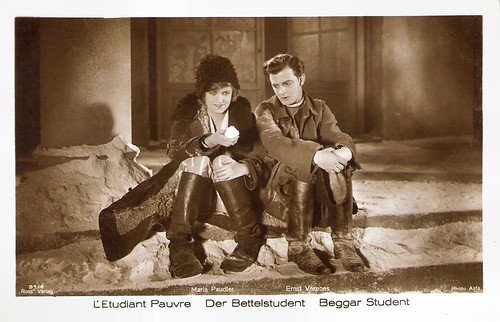
German postcard by Ross Verlag, no. 91/4. Photo: Aafa Film. Publicity still for Der Bettelstudent/The Beggar Student (Jacob Fleck, Luise Fleck, 1927) with Maria Paudler.
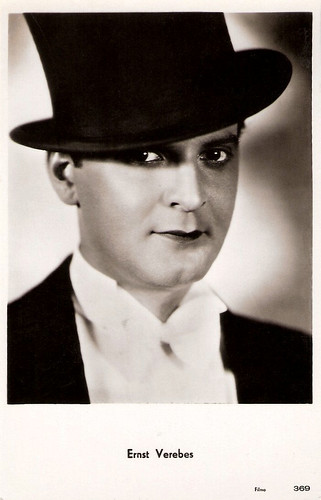
Dutch postcard by Filma, no. 369.
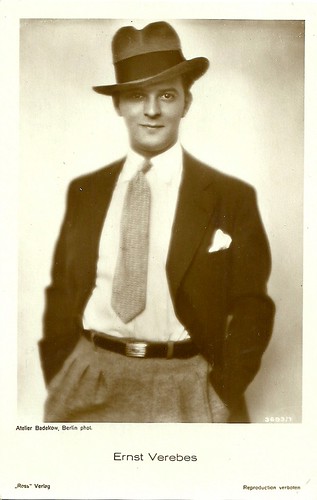
German postcard by Ross Verlag, no. 3693/1, 1928-1929. Photo: Atelier Badekow, Berlin.
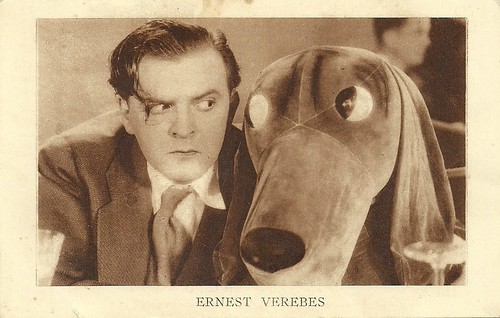
Belgian postcard. by S.A. Cacao et Chocolat Kivou, Vilvo[o]rde, Belgium. For either a late silent or early sound film.
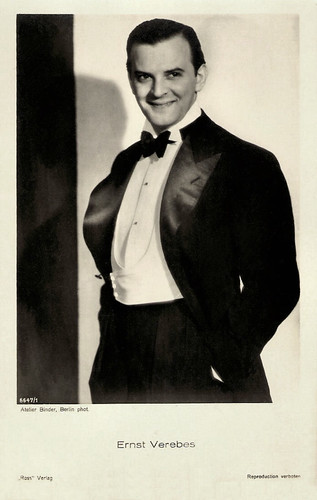
German postcard by Ross Verlag, no. 6647/1, 1931-1932. Photo: Atelier Binder, Berlin.
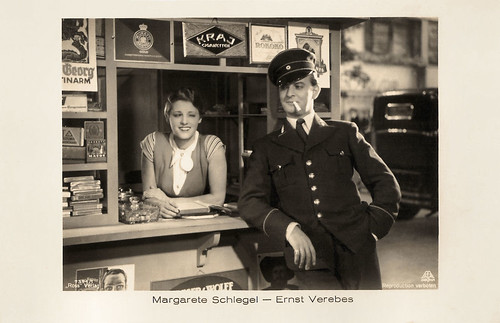
German postcard by Ross Verlag, no. 7394/1, 1932-1933. Photo: Aafa Film. Publicity still for Das blaue vom Himmel/The Blue from the Sky (Victor Janson, 1932) with Margarete Schlegel.
The German public acclaimed Ernst Verebes, especially in roles in uniform, such as the dashing hussar lieutenant in Der Tanzhusar/The Dancing Hussar (Fred Sauer, 1931) with Gretl Theimer. In the early 1930s he appeared in a whole string of German films including Va Banque (Erich Waschneck, 1930) starring Lil Dagover, Viktoria und ihr Husar/Victoria and Her Hussar (Richard Oswald, 1931), Die verliebte Firma/The Company's in Love (Max Ophüls, 1932), and Es wird schon wieder besser/Things Are Getting Better Already (Kurt Gerron, 1932) starring Dolly Haas and Heinz Rühmann.
Verebes was not desired by the Nazis and he moved to Austria where he appeared in Katharina die Letzte/Catherine the Last (Henry Koster, 1935) featuring Franciska Gaál. After the Anschluss of Austria to Nazi-Germany in 1936 Verebes decided to flee again and to take refuge in the US.
His career resumed there two years later but his matinee idol years were over. Verebes, now named Ernö again, first found a few acceptable supporting roles, mainly as the German or SS officer in office. He was seen in such films as A Desperate Adventure (John H. Auer, 1938) starring Ramon Novarro, Balalaika (Reinhold Schünzel, 1939), and The Hitler Gang (John Farrow, 1944). He is particularly memorable in a non military part, as the stage manager in Ernst Lubitsch's classic To Be or Not To Be (Ernst Lubitsch, 1942).
After World War Two, he was only given bit parts to play. Guy Bellinger at IMDb: "a far cry from the star status he benefited from only one or two decades earlier. The strange thing is that, whatever the type a film he was in, he was most of the time cast as a ... waiter! For years on, in at least fifteen movies, he would serve drinks to actors and actresses lucky enough to have something interesting to play. Sure there were variants, Ernö Verebes could be a bartender, a head waiter, a wine steward or the captain of waiters but the former popular and elegant star understandably tired of unceasingly repeating the same ancillary gestures, he who had been a count, a hussar and a Don Juan."
Verebes decided to retire in 1953, only 51. His last bit part was in Houdini (George Marshall, 1953) starring Tony Curtis. Ernö Verebes died forgotten in 1971 in Los Angeles, at the age of 68.
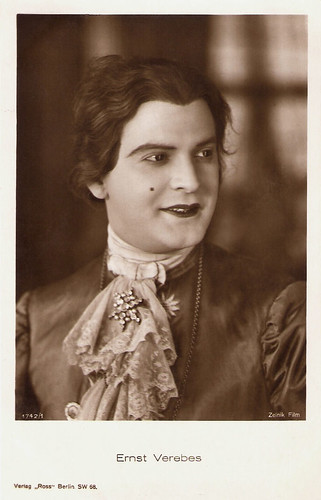
German postcard by Ross Verlag, no. 1742/1, 1927-1928. Photo: Zelnik Film.
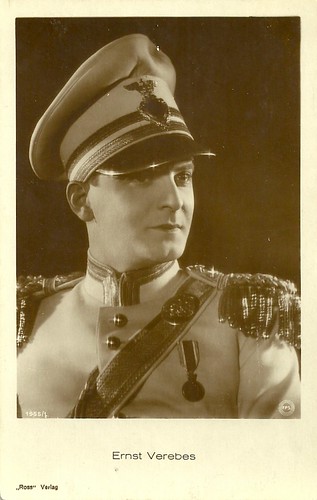
German postcard by Ross Verlag, no. 1955/1, 1927-1928. Photo: FPS.
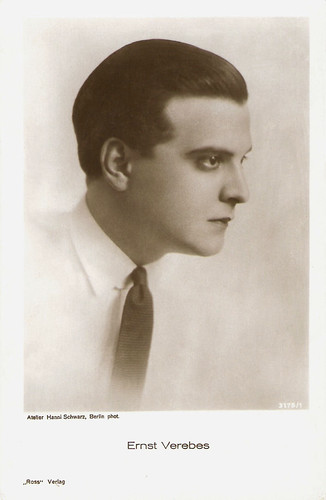
German postcard by Ross Verlag, no. 3175/1, 1928-1929. Photo: Atelier Hanni Schwarz, Berlin.
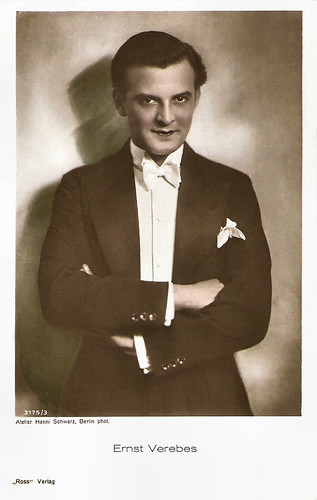
German postcard by Ross Verlag, no. 3175/3, 1928-1929. Photo: Hanni Schwarz, Berlin.
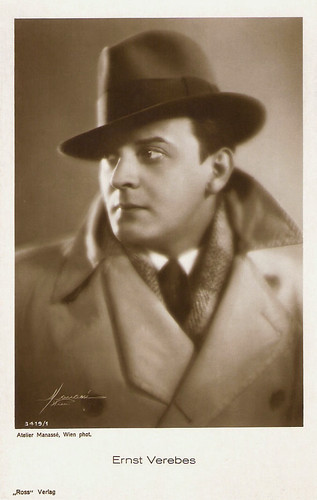
German postcard by Ross Verlag, no. 3419/1, 1928-1929. Photo: Atelier Atelier Manassé, Wien.
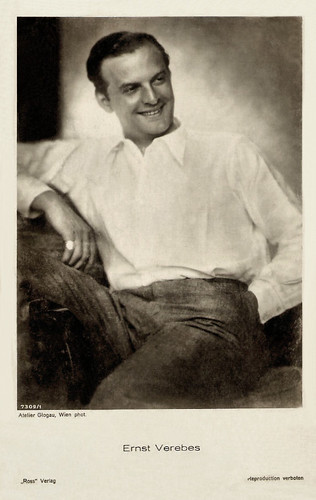
German postcard by Ross Verlag, no. 7309/1, 1932-1933. Photo: Atelier Glogau, Wien (Vienna).
Sources: Guy Bellinger (IMDb), Thomas Staedeli (Cyranos), Wikipedia, and IMDb.

German postcard by Ross Verlag, no. 1483/1, 1926-1927. Photo: Hanni Schwarz, Berlin.

German postcard by Ross Verlag, no. 1782/2, 1926-1927. Photo: Alex Binder.

German postcard by Ross Verlag, no. 3507/1, 1928-1929. Photo: Atelier Hanni Schwarz, Berlin.

German postcard by Ross Verlag, no. 3568/1, 1928-1929. Photo: Felsom-Film. Publicity still for Der fesche Husar (Geza von Bolvary, 1929).

German postcard by Ross Verlag, no. 5874/1, 1930-1931. Photo: Milan Kaufmann, Zagreb.

German postcard by Ross Verlag, no. 6146/1, 1931-1932. Photo: Aafa Film.
Hungary
Ernst Verebes was born as Ernö Verebes in New York in 1902. In 1914 his family returned to Hungary and there his film career began with Mire megvénülünk/The Seventh Veil (Ödön Uher ifj., 1917) and the Charles Dickens adaptation Twist Olivér/Oliver Twist (Márton Garas, 1919).
In the 1920s he appeared in such Hungarian films as A hetedik Fatyol (János Vanicsek, 1922), A Pál-utcai fiúk (Béla Balogh, 1924) based on a novel by Ferenc Molnár, and Holnap kezdödik az élet (Antal Forgács, 1924) with Maria Corda.
From 1925 on he became established as Ernst Verebes in the German film industry. He appeared in such films as Der Mann im Sattel/The Man in the Saddle (Manfred Noa, 1925), Gräfin Mariza/Countess Mariza (Hans Steinhoff, 1925), and Qualen der Nacht/Torments of the Night (Kurt Bernhardt/Curtis Bernhardt, 1926) with Claire Rommer.
Guy Bellinger at IMDb writes: "he was one of those manly actors, both well-built and charming, at ease as well in a military uniform as in a tuxedo and top hat, that German ladies loved to see on a big screen." Many more films followed, including Bigamie/Bigamy (Jaap Speyer, 1927) starring Heinrich George, Der Geisterzug/Ghost Train (Géza von Bolvary, 1927), Der Bettelstudent/The Beggar Student (Jacob Fleck, Luise Fleck, 1927) with Harry Liedtke.
Verebes appeared as a count opposite Lya Mara in Der Zigeunerbaron/The Gypsy Baron (Friedrich Zelnik aka Frederic Zelnik, 1927), and starred in Das Land ohne Frauen/Bride Number 68 (Carmine Gallone, 1929). Incidentally he also made Hungarian films like A Pál-utcai fúk/Paul Street Boys (Bela Balogh, 1929), based on a novel by Ferenc Molnar.

German postcard by Ross Verlag, no. 91/4. Photo: Aafa Film. Publicity still for Der Bettelstudent/The Beggar Student (Jacob Fleck, Luise Fleck, 1927) with Maria Paudler.

Dutch postcard by Filma, no. 369.

German postcard by Ross Verlag, no. 3693/1, 1928-1929. Photo: Atelier Badekow, Berlin.

Belgian postcard. by S.A. Cacao et Chocolat Kivou, Vilvo[o]rde, Belgium. For either a late silent or early sound film.

German postcard by Ross Verlag, no. 6647/1, 1931-1932. Photo: Atelier Binder, Berlin.

German postcard by Ross Verlag, no. 7394/1, 1932-1933. Photo: Aafa Film. Publicity still for Das blaue vom Himmel/The Blue from the Sky (Victor Janson, 1932) with Margarete Schlegel.
Germany and Hollywood
The German public acclaimed Ernst Verebes, especially in roles in uniform, such as the dashing hussar lieutenant in Der Tanzhusar/The Dancing Hussar (Fred Sauer, 1931) with Gretl Theimer. In the early 1930s he appeared in a whole string of German films including Va Banque (Erich Waschneck, 1930) starring Lil Dagover, Viktoria und ihr Husar/Victoria and Her Hussar (Richard Oswald, 1931), Die verliebte Firma/The Company's in Love (Max Ophüls, 1932), and Es wird schon wieder besser/Things Are Getting Better Already (Kurt Gerron, 1932) starring Dolly Haas and Heinz Rühmann.
Verebes was not desired by the Nazis and he moved to Austria where he appeared in Katharina die Letzte/Catherine the Last (Henry Koster, 1935) featuring Franciska Gaál. After the Anschluss of Austria to Nazi-Germany in 1936 Verebes decided to flee again and to take refuge in the US.
His career resumed there two years later but his matinee idol years were over. Verebes, now named Ernö again, first found a few acceptable supporting roles, mainly as the German or SS officer in office. He was seen in such films as A Desperate Adventure (John H. Auer, 1938) starring Ramon Novarro, Balalaika (Reinhold Schünzel, 1939), and The Hitler Gang (John Farrow, 1944). He is particularly memorable in a non military part, as the stage manager in Ernst Lubitsch's classic To Be or Not To Be (Ernst Lubitsch, 1942).
After World War Two, he was only given bit parts to play. Guy Bellinger at IMDb: "a far cry from the star status he benefited from only one or two decades earlier. The strange thing is that, whatever the type a film he was in, he was most of the time cast as a ... waiter! For years on, in at least fifteen movies, he would serve drinks to actors and actresses lucky enough to have something interesting to play. Sure there were variants, Ernö Verebes could be a bartender, a head waiter, a wine steward or the captain of waiters but the former popular and elegant star understandably tired of unceasingly repeating the same ancillary gestures, he who had been a count, a hussar and a Don Juan."
Verebes decided to retire in 1953, only 51. His last bit part was in Houdini (George Marshall, 1953) starring Tony Curtis. Ernö Verebes died forgotten in 1971 in Los Angeles, at the age of 68.

German postcard by Ross Verlag, no. 1742/1, 1927-1928. Photo: Zelnik Film.

German postcard by Ross Verlag, no. 1955/1, 1927-1928. Photo: FPS.

German postcard by Ross Verlag, no. 3175/1, 1928-1929. Photo: Atelier Hanni Schwarz, Berlin.

German postcard by Ross Verlag, no. 3175/3, 1928-1929. Photo: Hanni Schwarz, Berlin.

German postcard by Ross Verlag, no. 3419/1, 1928-1929. Photo: Atelier Atelier Manassé, Wien.

German postcard by Ross Verlag, no. 7309/1, 1932-1933. Photo: Atelier Glogau, Wien (Vienna).
Sources: Guy Bellinger (IMDb), Thomas Staedeli (Cyranos), Wikipedia, and IMDb.
1 comment:
A very good-looking man. What a shame his career was cut short. He obviously had a talent for languages, too.
Post a Comment